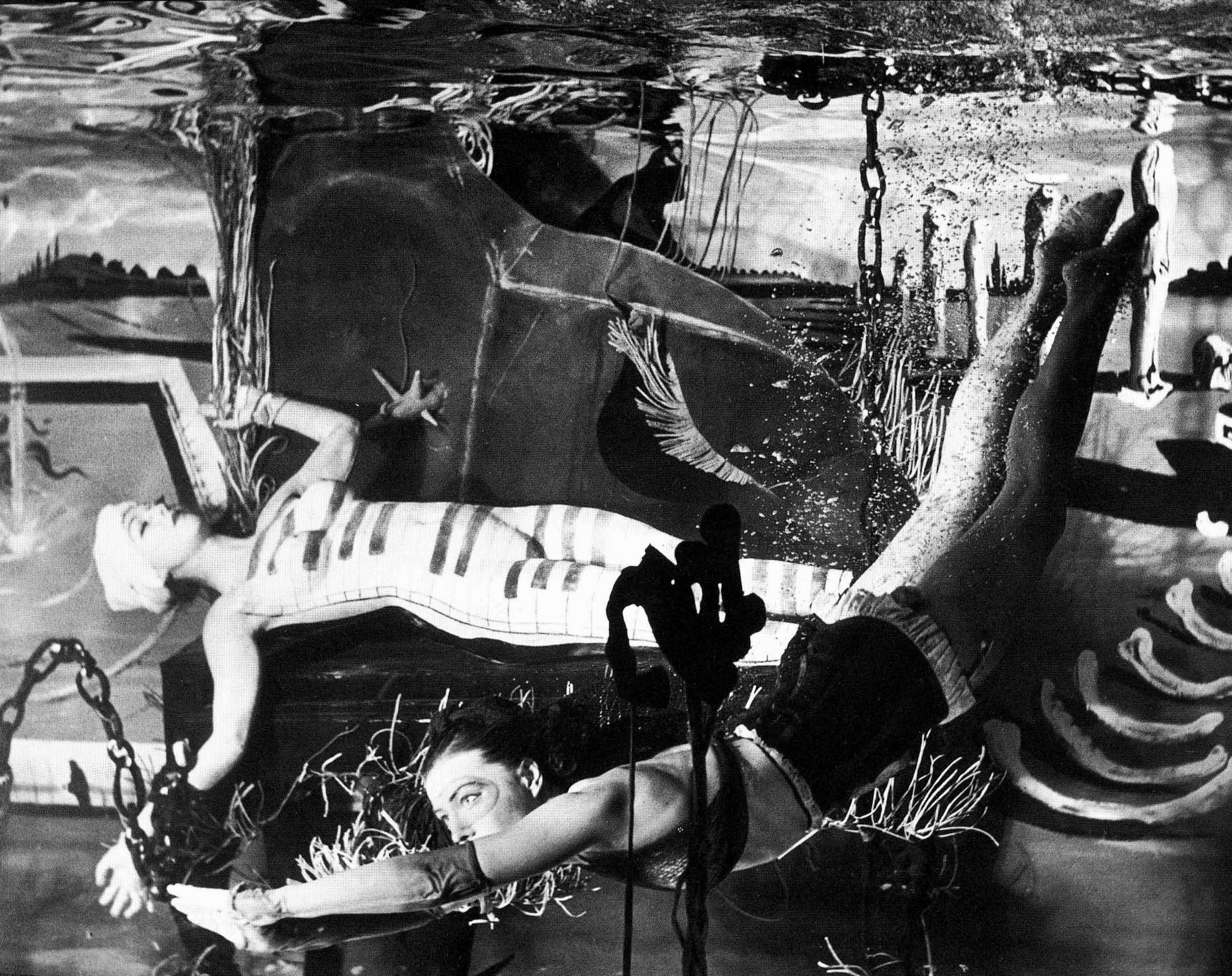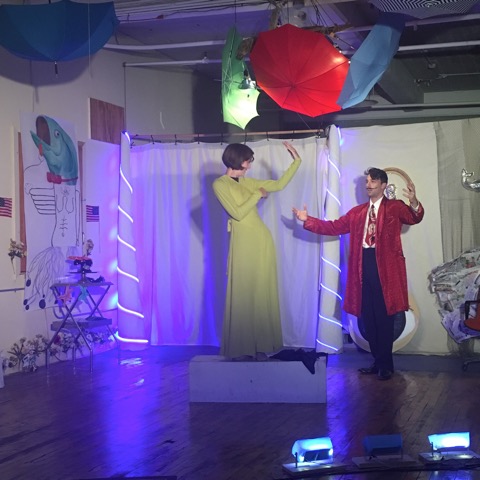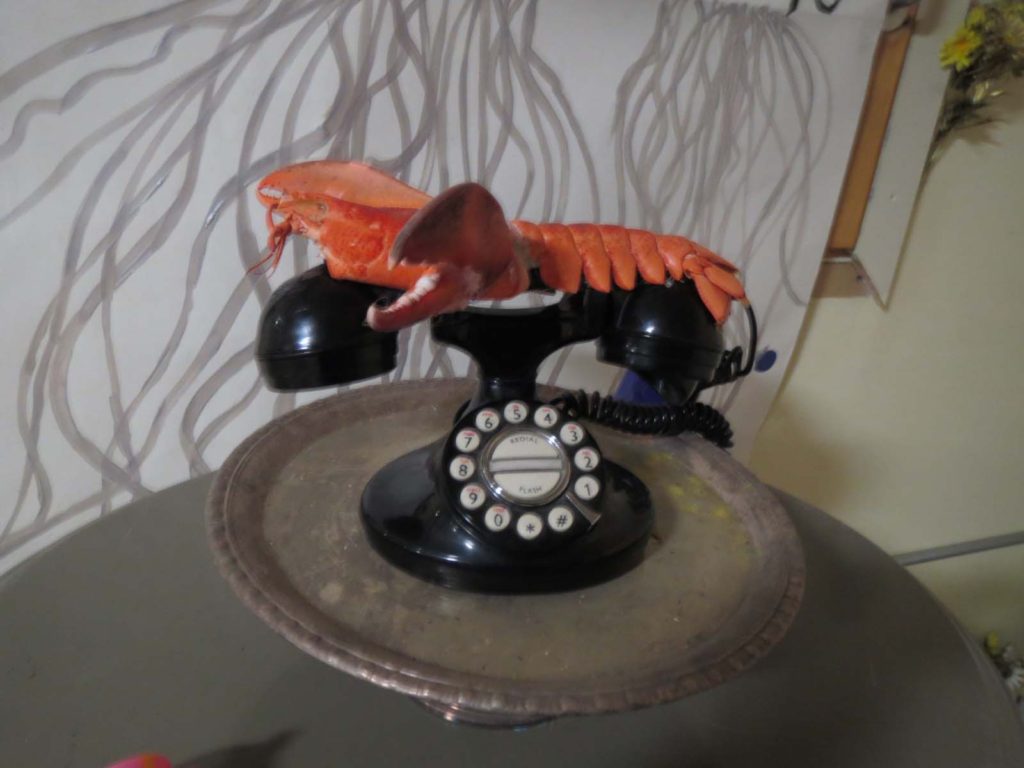by Jeff Grygny

“Do you think he’s crazy?” asks the reporter.
“Right now,” Nadia replies, “He’s my boss.”
“He” is Salvador Dali, and she’s one of the models hired to play mermaids in a giant water tank for his exhibit “Dali’s Dream of Venus” at the 1939 World’s Fair (one of them has to pretend to milk a plastic cow). That might be the only actual historical fact in Dali’s Liquid Ladies by Chicago playwright Savanna Reich, which is currently in performance by the “pop-up collective” called Truepenny Theater Company. What we get is as rich and strange as a surrealist painting: a smart, lovely, hilarious performance that takes Dali’s exhibit as the departure point for a journey through dreams, desire, power, art, meaning, and reality itself.
One of the fun things about shows by under-the-radar theater groups is the adventure of finding them: often they perform in unusual spaces where it’s an experience just getting there. There’s also a real risk: you might find young genius in the bud, or equally likely, some half-assed fiasco or pretentious bullshit. With this show, you get the feeling you’re in good hands when you’ve climbed several flights of stairs in the Fortress, a grand industrial building with castle-like pediments, and you see construction-paper fish fastened to the walls, each one inscribed with a different dream. This is also helpful, as the pause lets your heart slow down a little. A couple more flights, and a sign cheerily encourages you “Almost There!” The stairwell goes dark, lit only by a glowing disk on the landing. You hear live music, then burst into somebody’s loft living space. There’s a kitchen, a library; people sit at long tables apparently doing some kind of crafts. A large sign greets you with a playful warning strangely reminiscent of the waiver form from Willy Wonka and the Chocolate Factory.

Clearly, this show is a labor of love. Produced by Kat Wodke, who also plays Nadia, and directed with exceptional heart by Tessara Morgan, the show is a complete delight, all the collaborators working to create an organic whole of setting, costumes, music, lighting, and amazing performances. In a spot-on turn as “The Wizard of Painting,” Nick Narcisi nails Dali’s preternatural confidence, arrogance, and vision. He’s cool, off-putting and hilarious, delivering streams of surrealist word salad in a Catalan accent thick enough to spread on crackers (grasshopper” comes out “gray supper”). The three mermaids, played by Keighley Sadler, Molly Corkins, and Kat Wodktke, each have distinct characters and moments. Ben Yela as a lost Nazi is disarmingly naive and also very funny. All the players bring tremendous presence to their performance, taking time to break the fourth wall and reveal themselves, effectively becoming living works of art.

Devotion to art glows in every aspect of the production, from set designer Luke Farley’s painstakingly crafted lobsterphone, to Leslie Vaglica’s costumes, which recall Dali’s 1939 exhibit and sometimes become sculptural special effects, as when the actresses crouch inside sheer fabric cocoons illuminated from within. Don Russell’s MacGyver-like lighting rig uses hardware store tech to create rich and varied moods. Even Morgan’s musical choices conjure a period sense of theatrical weirdness.

Reich’s smart, poetic script hangs a lot of images and ideas on a fairly simple plot: Not satisfied with his work, Dali is keeping his three mermaids virtual captives in the closed exhibit (a situation any actor kept overtime by a crazy director can relate to). He treats them like objects: Ruby has to stand silent and motionless as he attaches live starfish to her nipples and drapes her in seaweed and raw bacon. “Why is the face of a woman more beautiful than the face of a fish?” he rails. “The face of a fish is fantastic!” What’s more, he finds their amorous advances trite and disgusting. Nadia thinks he’s a fake; Ruby tries in vain to get a straight answer from him; Opal simply seems out of her depth. Nor does their mood improve when a cadet from the Hitler Youth Group wanders into the exhibit, mistaking it for the German Pavilion. Intrigued, Dali tells him that it’s a laboratory for discovering the true Aryan spirit. “We’re taking it in a different direction,” he says to the confused Nazi. After experiencing the fleshy embrace of Dali’s human massage chair, the young Fascist flees, but soon returns, beginning a curiously intimate male bonding process with the painter, including a bizarre, if kind of adorable, game of “Truth or Dare” in a makeshift pup tent. None of this improves the ladies’ mood, and like the ecstasy-maddened Bacchantes in the myth of Orpheus, they resolve to murder the famous artist.
Clearly, Reich had a blast writing this play, and the young players bring great heart and imagination to flesh it out. Not only do they fully realize the script, they might, following their own imaginative threads, radically expand upon it. For instance, it’s well-known that Dali was not a very nice man. His fellow artists detested him as a materialistic, self-aggrandizing sell-out, and criticized his support of Fascist regimes. The myth of the “Great Genius” has supported tyrants both great and small. Reich’s play obviously points to homoerotic, misogynistic aspects of the relationship between Dali and the Lost Nazi as well. Marvelously, this production doesn’t take an easy, doctrinaire path; the ideas are still there, but warmed and humanized. Morgan’s sensitive work with the superb cast discovers something more fluttering and alive. They show that even if an artist’s singular vision can alienate and confuse people, it can also liberate their own personal visions.
In one telling Dali reveals a spirit racked with fears and conflicting emotions. He’s afraid of mediocrity and afraid people won’t understand him. He’s afraid of grasshoppers, and that he might accidentally step on a fish. He’s afraid that his crowd of admirers might touch him. Though the other players bare their bodies, he shows his naked soul. An artist, gifted or cursed with perceptions unbound by cultural clichés, is a giant eyeball, a living nerve exposed to the universe. And lo and behold: tyrant though he may be, his creativity seems to effect deep transformations on his associates. The seemingly clueless Opal turns herself into a living brush, dripping blue paint over her body to make imprints on a large canvas. Ruby dreams of a Dali who acknowledges and sees her, drawing power in the act. And the inhibited Nazi sheds his uniform to dance fearless and ecstatic, liberated from his rigid ideology.
Morgan writes in her program notes,“Surrealism offers a chance to be whoever you want to be.” It could be the motto for any counterculture, for cosplay, or for identity movements: the Romantic celebration of the individual’s sometimes painful existential task of creating one’s own reality. History is full of terrible instances of geniuses imposing their version of reality on others. But as E.E. Cummings wrote in A Poet’s Advice:
“. . . whenever you think or you believe or you know, you’re a lot of other people: but the moment you feel, you’re nobody-but-yourself.”
Truepenny Theater Company presents
Dali’s Liquid Ladies
by Savanna Reich
Playing through October 15
at the Fortress (corner of 1st and Pleasant St. in Milwaukee)
Surrealist Funhouse Opens at 7:00
Live Music at 7:30
Show at 8:00
Suggested donation $15-25 (CASH ONLY)
“All are welcome! No one turned away for lack of funds.”
